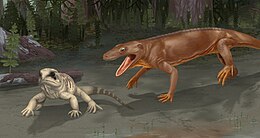| Nooxobeia Temporal range:
Early Permian,
| |
|---|---|

| |
| Life restoration of Nooxobeia gracilis (right) based on specimen UCLA VP 3066. | |
|
Scientific classification
| |
| Domain: | Eukaryota |
| Kingdom: | Animalia |
| Phylum: | Chordata |
| Order: | † Temnospondyli |
| Family: | † Dissorophidae |
| Genus: | †
Nooxobeia Gee, Scott & Reisz, 2018 |
| Type species | |
| †Nooxobeia gracilis Gee, Scott & Reisz, 2018
| |
Nooxobeia is an extinct genus of dissorophid temnospondyl from the Early Permian ( Guadalupian) of Oklahoma. The generic name is derived from the Arapaho (a language spoken in the type locality of the holotype) word nooxobe, which means frog. [1]
Taxonomy
Olson (1972) referred a complete dissorophid specimen (UCLA VP 3066) from the Chickasha Formation of Oklahoma to Fayella chickashaensis based on cranial similarities to the holotype. [2] However, in 2018, Gee, Scott and Reisz declared Fayella a nomen dubium and an indeterminate temnospondyl, and made UCLA VP 3066 the holotype of the new species Nooxobeia gracilis. [1]
See also
References
- ^ a b Gee, Bryan M.; Scott, Diane; Reisz, Robert R. (2018). "Reappraisal of the Permian dissorophid Fayella chickashaensis". Canadian Journal of Earth Sciences. 55 (10): 1103–1114. doi: 10.1139/cjes-2018-0053.
- ^ Olson, Everett C. (1972). "Fayella chickashaensis, the Dissorophoidea and the Permian Terrestrial Radiations". Journal of Paleontology. 46 (1): 104–114. JSTOR 1302919.

